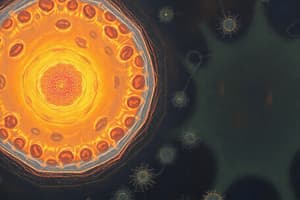Podcast
Questions and Answers
Which of the following statements accurately describes a key difference between prokaryotic and eukaryotic cells?
Which of the following statements accurately describes a key difference between prokaryotic and eukaryotic cells?
- Prokaryotic cells carry out photosynthesis in chloroplasts, while eukaryotic cells generate energy through cellular respiration in the cytoplasm.
- Prokaryotic cells lack membrane-bound organelles, while eukaryotic cells contain membrane-bound organelles such as mitochondria and a nucleus. (correct)
- Prokaryotic cells are typically 10-100 micrometers in size, while eukaryotic cells are 1-10 micrometers in size.
- Prokaryotic cells contain multiple linear chromosomes within a nucleus, while eukaryotic cells have a single circular chromosome in the cytoplasm.
A scientist is studying a cell under a microscope and observes the presence of ribosomes. This observation suggests that the cell is actively performing which function?
A scientist is studying a cell under a microscope and observes the presence of ribosomes. This observation suggests that the cell is actively performing which function?
- Generating energy through cellular respiration.
- Synthesizing lipids for membrane production.
- Breaking down waste and cellular debris.
- Synthesizing proteins by translating genetic instructions. (correct)
Which cellular structure is primarily responsible for modifying, sorting, and packaging proteins and lipids for transport within and outside the cell?
Which cellular structure is primarily responsible for modifying, sorting, and packaging proteins and lipids for transport within and outside the cell?
- Mitochondria
- Lysosome
- Endoplasmic Reticulum (ER)
- Golgi Body (correct)
Which of the following structures is NOT found in animal cells?
Which of the following structures is NOT found in animal cells?
What is the primary role of the cell membrane in maintaining cellular homeostasis?
What is the primary role of the cell membrane in maintaining cellular homeostasis?
Which of the following characteristics is NOT a fundamental tenet of the cell theory?
Which of the following characteristics is NOT a fundamental tenet of the cell theory?
How do pili contribute to the survival and adaptation of bacteria?
How do pili contribute to the survival and adaptation of bacteria?
A cell is observed to have a large vacuole. Which function can be inferred about the cell based on this observation?
A cell is observed to have a large vacuole. Which function can be inferred about the cell based on this observation?
Flashcards
Cell Theory
Cell Theory
All living organisms are composed of cells, the basic units of life, and all cells arise from pre-existing cells.
Multicellular Organisms
Multicellular Organisms
Organisms consisting of multiple cells that work together. Often are eukaryotes and have specialized functions.
Unicellular Organisms
Unicellular Organisms
Organisms consisting of only one cell.
Prokaryotic Cells
Prokaryotic Cells
Signup and view all the flashcards
Eukaryotic Cells
Eukaryotic Cells
Signup and view all the flashcards
Cell Wall
Cell Wall
Signup and view all the flashcards
Cell Membrane
Cell Membrane
Signup and view all the flashcards
Chloroplasts
Chloroplasts
Signup and view all the flashcards
Study Notes
- All organisms consist of cells
- Cells represent the basic units of life
- Cells come from pre-existing cells through multiplication
Multicellular Organisms
- Living organisms that consist of more than one cell
- Eukaryotes, examples include mushrooms, animals, and plants
- They have specialized functions
Unicellular Organisms
- Living organisms consisting of only one cell
- They aren't visible by the naked eye
Prokaryotic Cells
- Unicellular
- Size range is 1-10 micrometres
- Lack membrane-bound organelles, including a nucleus, mitochondria, chloroplasts, endoplasmic reticulum, Golgi body, and lysosomes
- Contain a single, circular chromosome located in the cytoplasm
- Example: Bacteria
Eukaryotic cells
- Size range is 10-100 micrometres
- Contain membrane-bound organelles
- Possess a nucleus
- Contain numerous linear chromosomes, housed within the nucleus
- Examples: plant and animal cells
Cell Structure and Functions
- Cell wall: Offers structural support and protection to plant, fungal, and bacterial cells
- Cell membrane: Regulates the movement of substances in and out of the cell
- Chloroplasts: Conduct photosynthesis, generating energy in plant cells
- Vacuole: Stores water, nutrients, and waste to maintain cell pressure
- Cytoplasm: Gel-like substance housing organelles and facilitating cellular processes
- Mitochondria: Generate energy (ATP) through cellular respiration
- Golgi body: Modifies, sorts, and packages proteins and lipids for transport
- Nucleus: Contains genetic material (DNA) and controls cell activities
- Endoplasmic reticulum (ER): Smooth ER synthesizes lipids, and rough ER produces proteins via ribosomes
- Ribosomes: Synthesize proteins by translating genetic instructions
- Lysosomes: Break down waste and cellular debris using digestive enzymes
- Vesicles: Transport materials within and outside the cell
- Capsule: Protective outer layer present in some bacterial cells
- Pili: Hair-like structures enabling bacteria to attach to surfaces and transfer DNA
- Flagellum: Whip-like structure facilitating cell movement
Studying That Suits You
Use AI to generate personalized quizzes and flashcards to suit your learning preferences.




